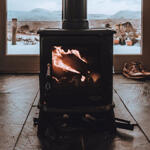

Why is my wood burner going out?
Wood burning stoves can provide plenty of warmth and a homely glow once your fire gets going. While rewarding, building a fire takes patience and practice. There’s nothing more frustrating than when your log fire keeps going out. To avoid disappointment, read on for a checklist on why this keeps happening.
Is your wood too wet?
Wood must possess a maximum of 20 per cent moisture to burn properly. Dried wood burns more effectively as stoves don’t have to boil off excess moisture before they start consuming fuel. Never put damp twigs and branches from your yard in a stove, they’ll put your fire out and create unpleasant smoke.
Instead, buy pre-dried wood that’s already seasoned and ready to use. Kiln dried hardwood logs are sold, offering slow burn times and the ideal moisture count.
Are you building your fire correctly?
If you try and burn a big log first, there’s a good chance your burner will struggle to catch fire and stay lit. Take your time and construct a framework with kindling. Make a tepee shape or create a grid in the bottom of your burner with small sticks. Next, add some medium-sized logs and light your framework. Once the medium-seized wood catches fire, you can add a bigger log. Adding too much wood can snuff out the flames, so be patient and let your fire get hot before bringing out the big logs.
Do you understand how to use the air vents?
When you start your fire, you’ll need the log burner air vents open as wide as they can go. This supplies your fire with the oxygen it needs to get a good blaze going. Once the fire catches, slowly close the vents. While leaving them open too wide will cause the fire to burn through your fuel too quickly, closing them too much can cause your fire to go out.
Looking for the perfect logs in London?
At London Gases, we stock a range of logs that are designed for wood burning stoves. If you’re looking for reliable supply for your wood burner in London, contact us today.
